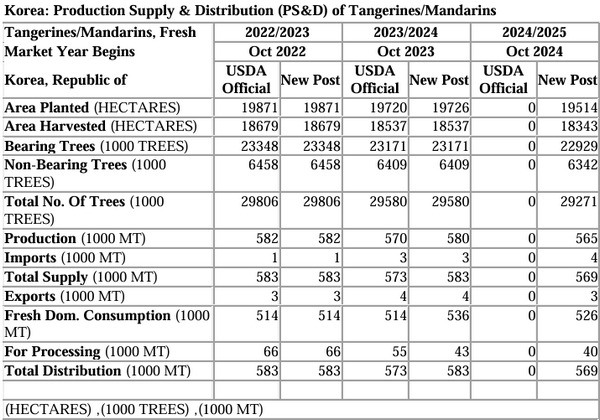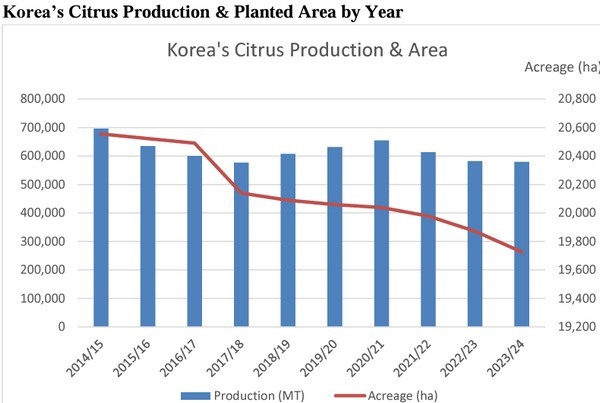South Korea's marketing year (MY) 2024/25 citrus production is forecast down 2.6 percent to 565,000 MT, a 10-year low, on gradually declining acreage and adverse weather conditions. Jeju Island, where nearly all Korean citrus is grown, experienced a prolonged summer heat wave lasting into mid-September, followed by excessive fall rain, which caused fruit cracking and rot. Citrus consumption increased in MY 2023/24, as shortages of other domestic fruit (apples, pears, persimmons) led consumers to substitute with amply supplied domestic mandarins and imported oranges, whose consumption increased by 4.3 and 11.5 percent, respectively. Imports of fresh oranges, mostly from the United States, are forecast down in MY 2024/2025, as emergency tariff rate quotas for imported fruit are not expected to be renewed. In June 2024, the United States gained market access for Texas grapefruit, and the first shipments are expected to arrive in Korea in December.
In marketing year (MY) 2024/25 (October 2024 to September 2025), Korea's tangerine/mandarin production is projected to reach 565,000 metric tons (MT), marking a 2.6percent decline (15,000 MT) from the previous year's 580,000 MT. This represents the lowest citrus production level in the past decade and is also about 8 percent lower than the five-year average production of 612,000 MT. The primary reason for this decline is the reduced harvest of open-field Unshu tangerines, which account for approximately 70 percent of total citrus production in Korea, because of gradually declining planted area, adverse weather conditions, and the alternate fruit-bearing cycle.
In 2024, Jeju Island, where nearly all Korean citrus is grown, experienced extreme heat during the summer season and frequent rainfall just before the harvest period (September to October), which led to increased rates of fruit cracking, fruit drop, and spoilage. Consequently, the 4 production of marketable fresh fruit for MY 2024/25 is expected to decrease. Fall rains particularly affected the quality of extra-early maturing and early maturing varieties and disrupted the harvest. Some late-maturing varieties such as Redhyang also experienced severe fruit cracking.
Additionally, the Seogwipo area of southern Jeju, a region responsible for around 65 percent of Jeju's citrus production, experienced an "off-year" in its alternate fruit-bearing cycle, further contributing to the overall reduction in citrus production. The northern part of Jeju typically follows the opposite fruit-bearing cycle, and thus had an "on-year" in 2024, partially offsetting the reduction in Seogwipo.
In September 2024, a crop survey conducted by the Jeju citrus industry forecasted open-field tangerine production for this season to reach approximately 400,000 MT, similar to the previous year (406,000 MT). However, they later revised their forecast downward by 20,000 MT to 380,000 MT due to frequent rainfall, which increased fruit cracking and spoilage.
To view the full report, click here.
 For more information:
For more information:
USDA
Tel: +1 (202) 720-2791
Email: [email protected]
www.usda.gov













